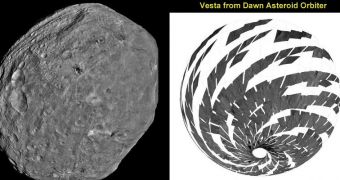Scientists managing the NASA Dawn spacecraft say that the vehicle's current position around the giant asteroid Vesta is enabling them to collect a wealth of data about what could have very well been the fifth planet from the Sun.
Many believe that Vesta is a protoplanet, the undeveloped core of what could have been a rocky planet just like our own. For unknown reasons, Vesta's growth was stopped during the earliest days of the solar system, which means that it endured solely as a very large asteroid.
In fact, this is the largest space rock in the entire solar system. The only things larger than Vesta are the 8 planets and 5 confirmed dwarf planets. Dawn was developed specifically to analyze this object, and then continue on to another interesting location in the Inner Asteroid Belt.
The protoplanet is around 530 kilometers (330 miles) in diameter, and is only exceeded in size by the dwarf planet Ceres. The latter is also located in the IAB, and will be a target for Dawn over the next few years.
Dawn is currently on a Low Altitude Mapping Orbit (LAMO) around the planet. Originally, plans called for it to remain on this path for about 70 days, but recent developments have allowed mission controllers at the NASA Jet Propulsion Laboratory to extend that time frame by 40 days.
“We are truly thrilled to be able to spend more time observing Vesta from low altitude. It is very exciting indeed to obtain such a close-up look at a world that even a year ago was still just a fuzzy blob,” JPL Dawn engineer, Dr. Marc Rayman, tells Universe Today.
During the course of its investigations of Vesta, Dawn is planned to transfer between four separate orbits. The spacecraft achieved orbital insertion around the asteroid in July 2011, and is expected to depart in July 2012.
At first, the LAMO stage was supposed to last for just 10 weeks. “With the additional 40 days it means we are now scheduled to leave LAMO on April 4. That’s when we begin ion thrusting for the transfer to HAMO2 [High Altitude Mapping Orbit 2],” Rayman explains.
The latter would take Dawn about 680 kilometers (422 miles) above the surface of the asteroid. Scientists hope that in-depth studies of this space rock will finally reveal why it stopped forming so long ago.
The investigation may also be able to provide additional insight into the early history of the solar system, and the processes that were involved in creating the planets, the IAB, the Kuiper Belt and the Oort Cloud.

 14 DAY TRIAL //
14 DAY TRIAL //